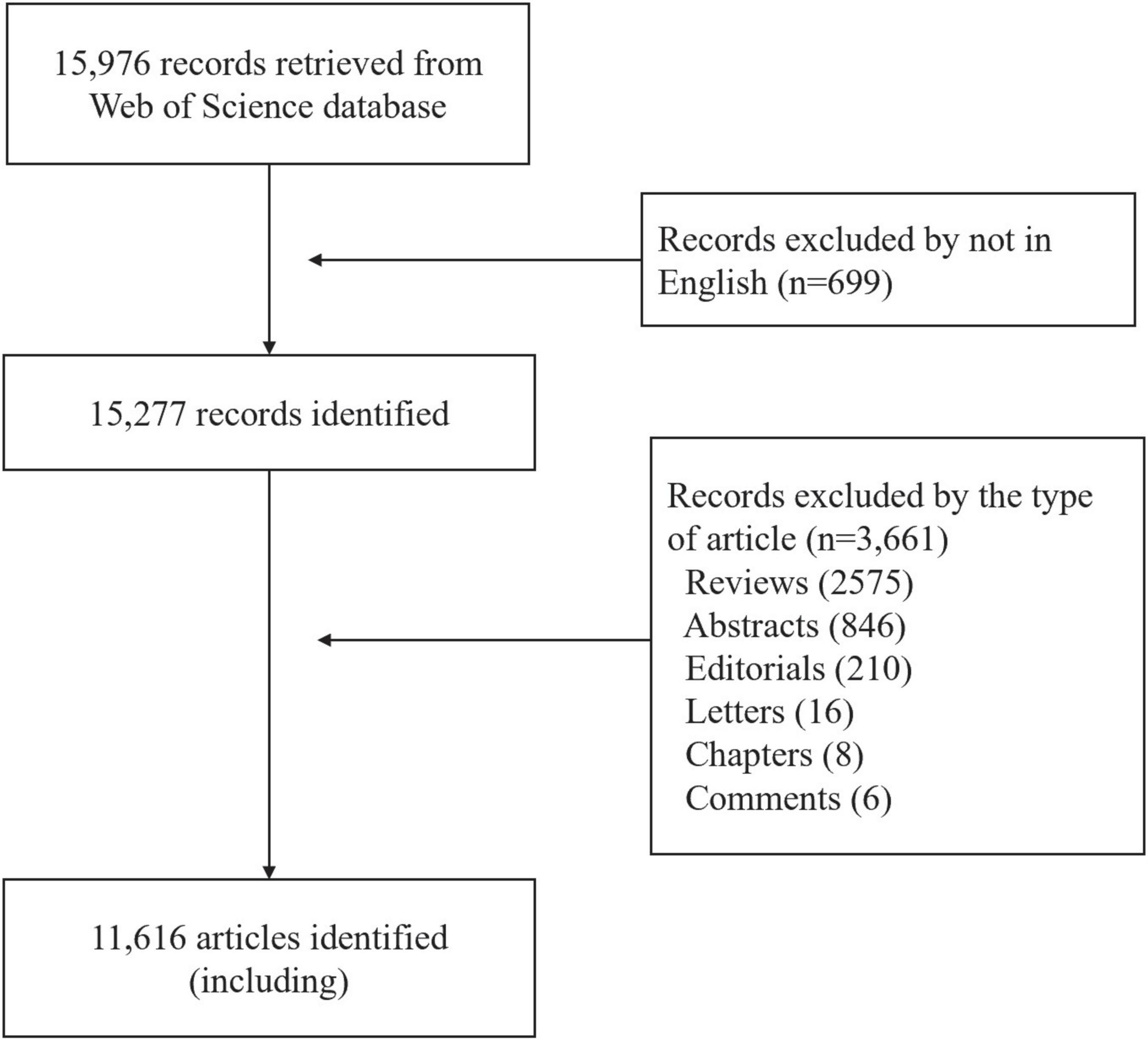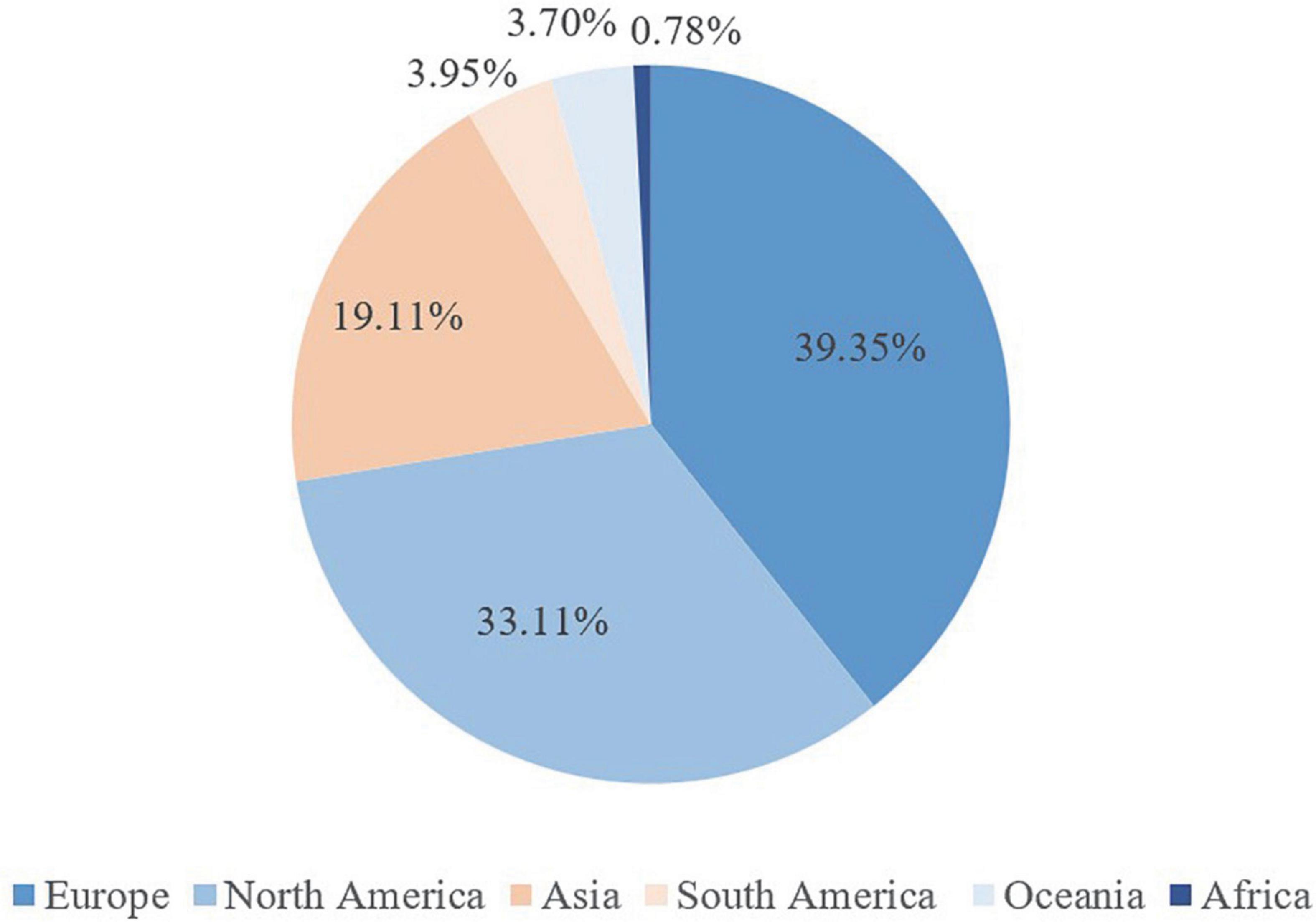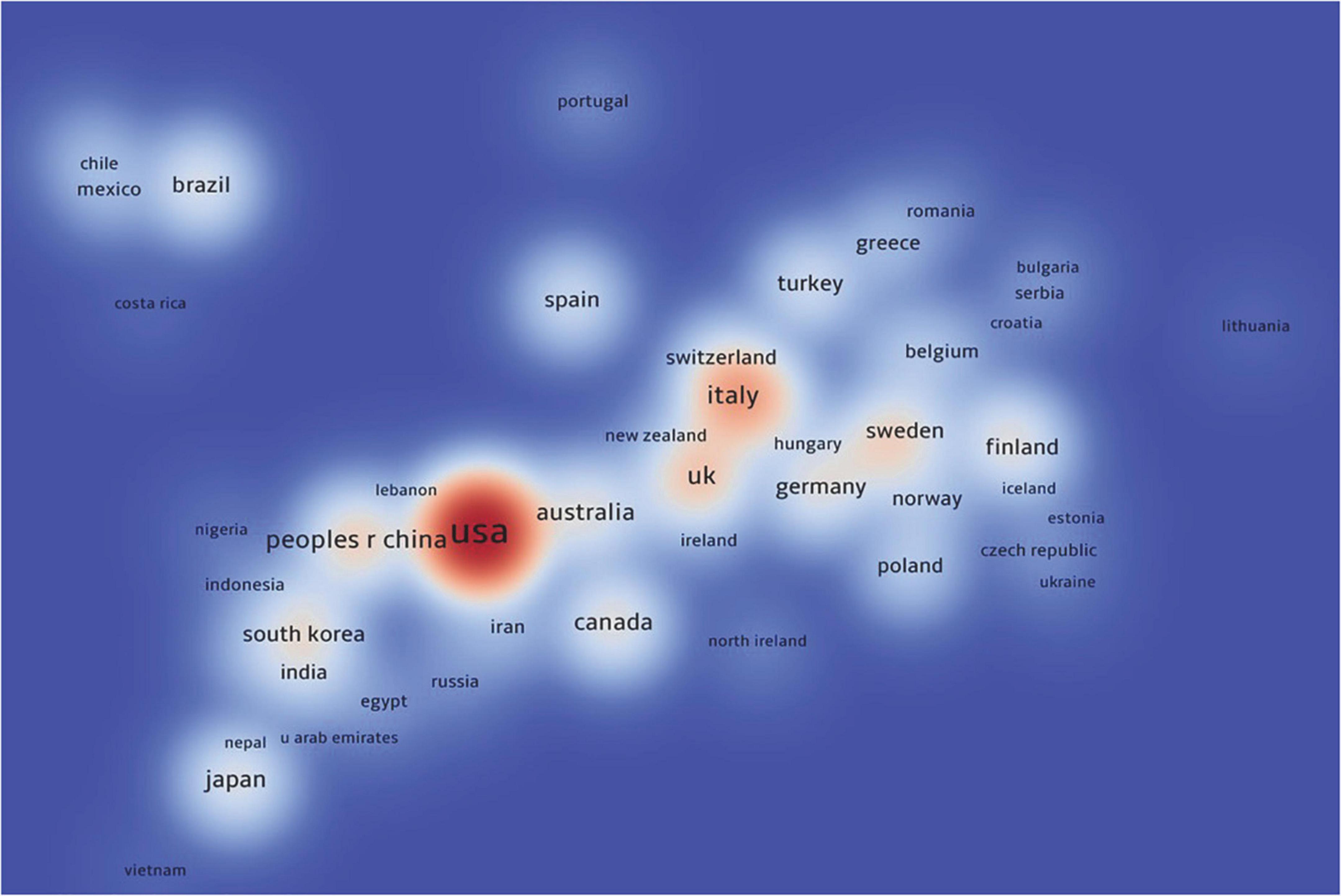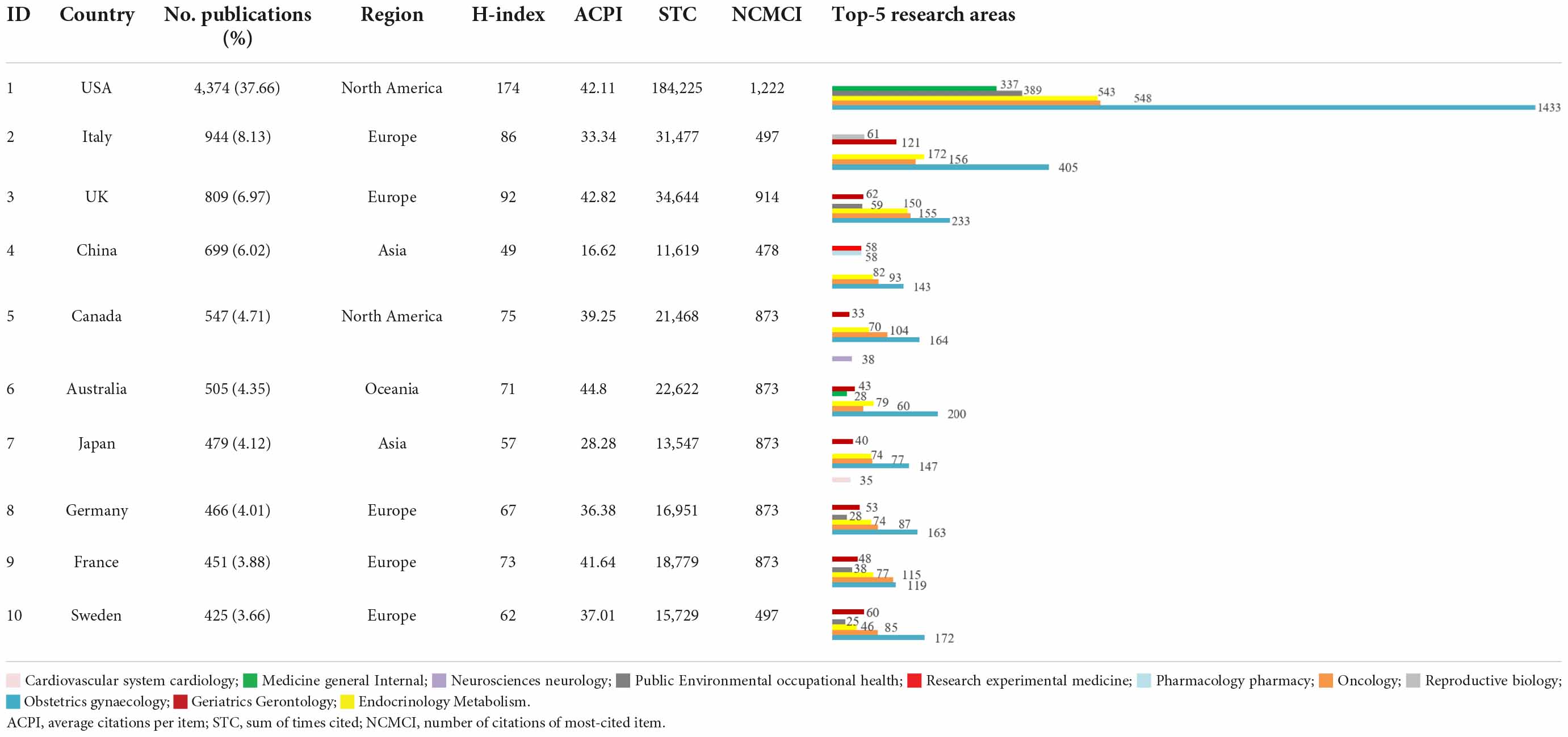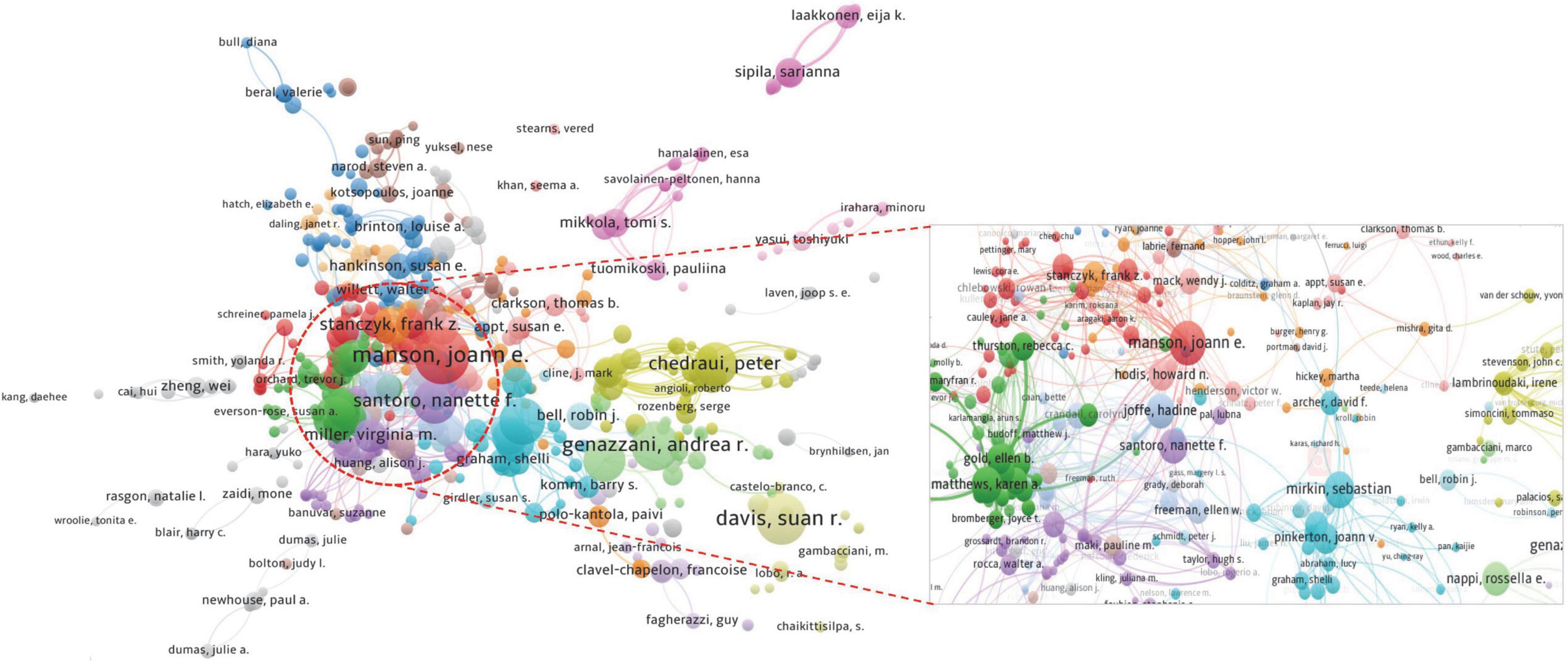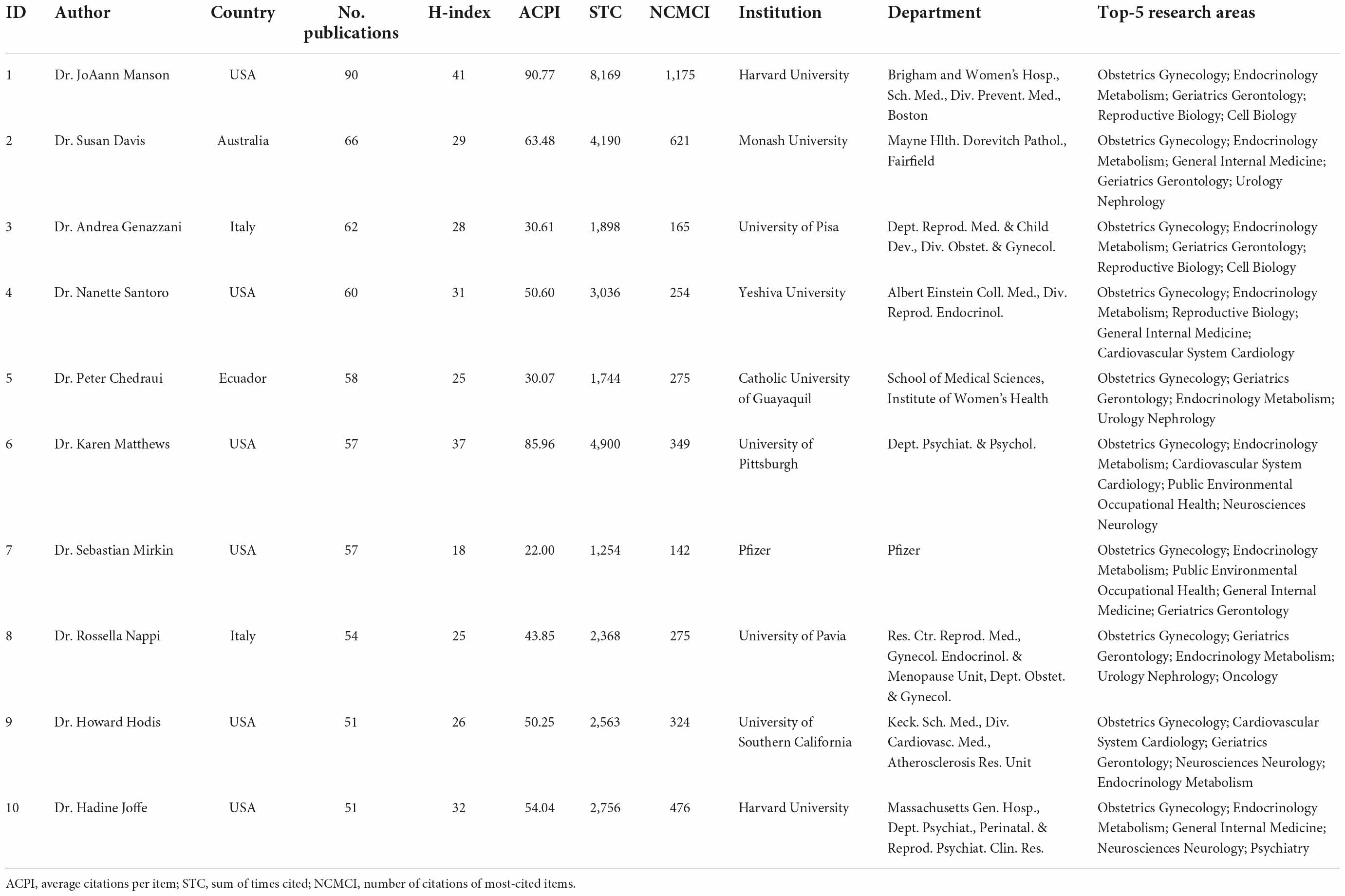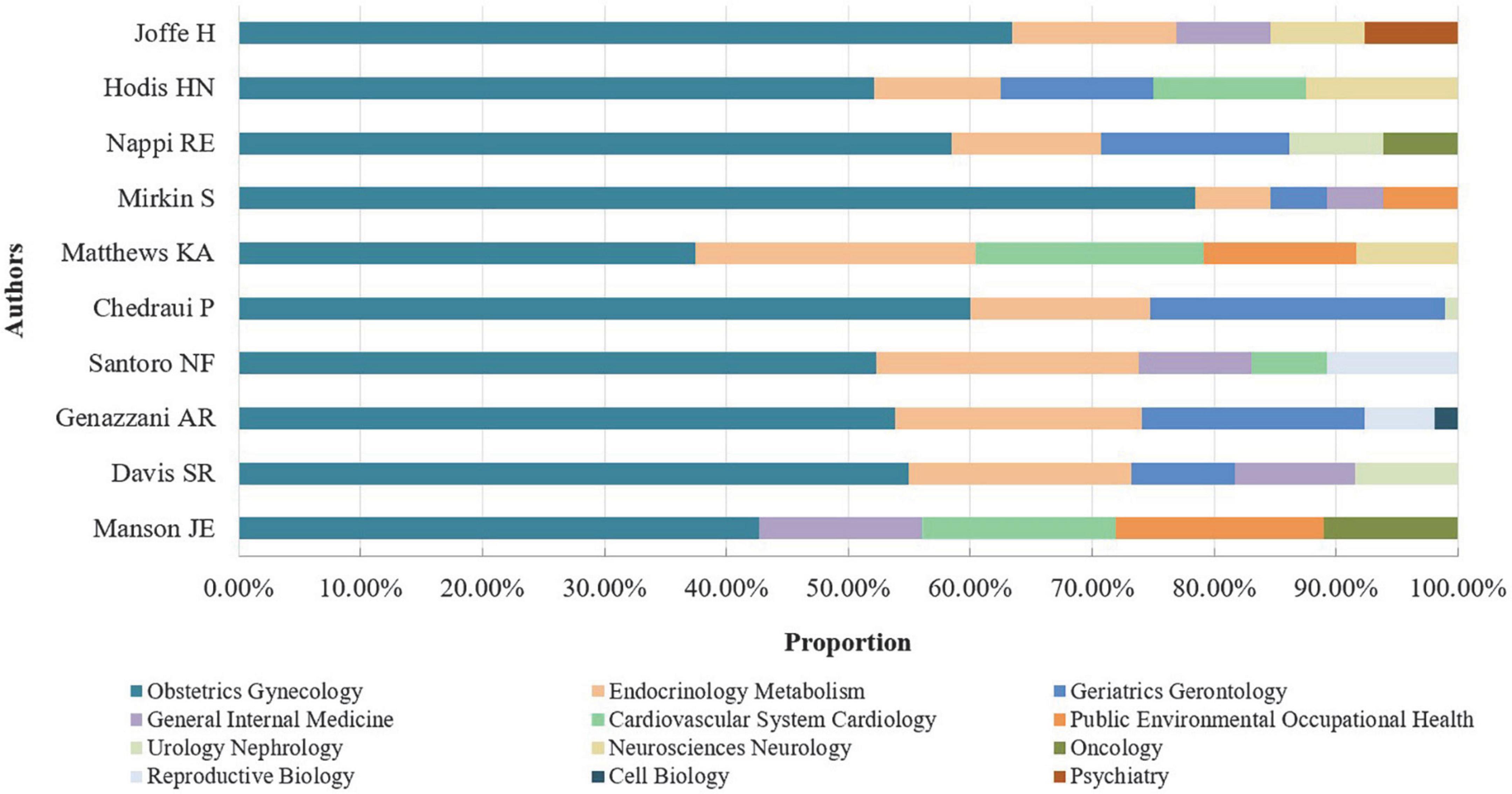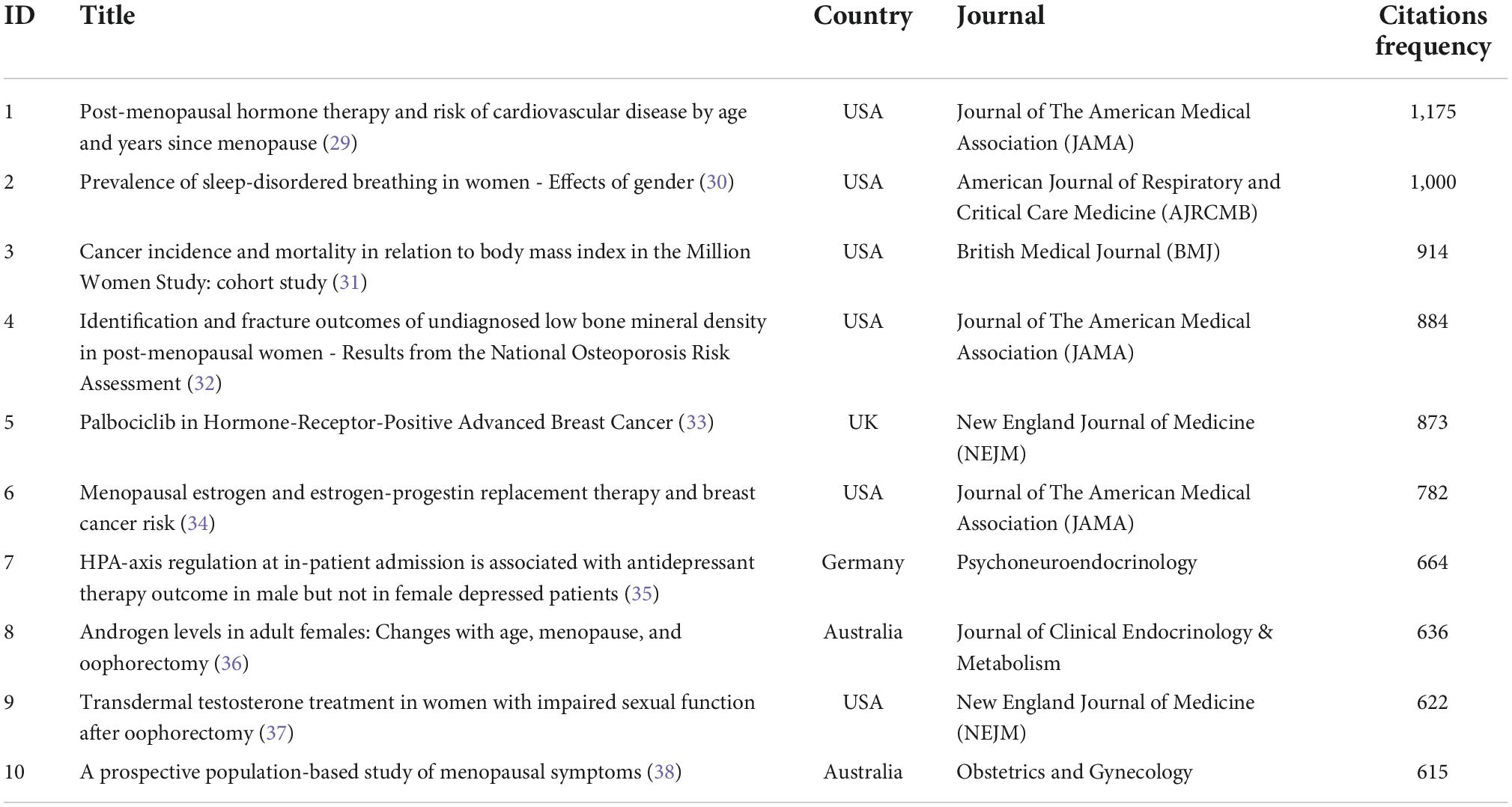- 1Evidence-Based Social Sciences Research Center/Health Technology Assessment Center, School of Public Health, Lanzhou University, Lanzhou, China
- 2Evidence-Based Medicine Center, School of Basic Medical Sciences, Lanzhou, China
- 3Key Laboratory of Evidence Based Medicine and Knowledge Translation of Gansu Province, Lanzhou, China
- 4First Clinical Medical College of Lanzhou University, Lanzhou, China
- 5Second Clinical Medical College of Lanzhou University, Lanzhou, China
- 6The First Hospital of Lanzhou University, Lanzhou, China
We conducted the present bibliometric analysis to explore menopausal hormone therapy (MHT)-related research trends between 2000 and 2021. The Web of Science database was systematically searched from 2000 to 2021 to retrieve MHT-related publications. Visualization mapping and keyword cluster graphs were utilized to illustrate the research topics and hotpots. We included 11,616 MHT-related publications for this bibliometric analysis. The results showed that (1) MHT-related research had a very slow increase in the past 22 years, and the trend fluctuated. Sum of times cited and average citations per item had the same trend: a sharp decline from 2002 to 2003, and a rapid increase from 2003 to 2006, reaching the peak in 2006, then following a downward trend. The average H-index was 57, peaking in 2001; (2) the USA, the League of European Research Universities, and Dr. JoAann Manson from Harvard University contributed the most; (3) Menopause: The Journal of The North American Menopause Society had the most significant number of MHT-related publications; (4) the research hotpots primarily focused on MHT for treating menopausal symptoms and the impact of MHT on women’s health. According to previous studies, MHT was the most effective treatment for managing vasomotor symptoms of menopause, but results from the clinical trials and observational studies regarding MHT adverse events remain inconsistent. Mechanisms are fundamental when clinical studies give conflicting results. Therefore, future studies should focus on adverse events and their mechanisms.
Introduction
Menopause is often associated with various unpleasant physical and mental symptoms, such as hot flashes and night sweats, insomnia, anxiety, depression, decreased libido, vaginal dryness, or difficulty concentrating. About 80% of menopausal women are affected by such symptoms; hot flashes and night sweats account for approximately 70% of midlife women (1). These symptoms have a significant adverse effect on daily functioning and the quality of life (2, 3). Clinical guidelines indicate that vasomotor symptoms of menopause (VMS) typically last from 6 months to 2 years. However, new researches suggest that for many women, the duration of symptoms could persist for a decade or even longer (1, 4).
Menopausal hormone therapy (MHT) has been utilized for over 50 years to treat menopausal women with hot flashes and other menopausal symptoms. MHT is the most effective treatment for managing VMS and improves the quality of life (5, 6). The two main hormones used in MHT are estrogen and progestogen, of which the latter was only used for women having a uterus. The two hormones usually come in several forms, like tablets, skin patches, estrogen gel, implants, and other types (7). With the use of MHT, thousands of published manuscripts have reported mechanistic (8, 9), therapeutic (10, 11), and preventive studies (9, 12). As for adverse events of MHT for menopausal women, the results from the clinical trials and observational studies regarding MHT adverse events remain inconsistent: the largest randomized controlled trial of MHT, Women’s Health Initiative (WHI), showed that compared with placebo, conjugated equine estrogen elevated the risk of dementia (13), breast cancer (14), and stroke (15). However, some observational studies reported a reduced risk of Alzheimer’s disease and all-cause dementia in users of MHT (11, 16–18), and utilizing exogenous estrogens was cardio-protective for post-menopausal women. Based on the conflicts, mechanisms are essential to understand complex systems (e.g., physiological or social systems) and can help us explain, predict, and intervene (19). Researchers may conduct horizontal and longitudinal studies to explore the adverse events and MHT-related mechanisms. It is ideal for clinicians to treat menopausal women after fully understanding MHT-related studies.
Bibliometric analysis is a statistical method used to analyze and visualize critical characteristics from published articles and identify research trends in a specific field through online literature databases (20–24). Our objective is to gain an enhanced understanding of existing research hotspots and potential trends and to provide appropriate reference guidelines for future research.
Methods and analysis
Data source and search strategy
Using the keywords that related to MHT: “Hormone Replacement Therapy,” “Estrogen Replacement Therapy,” “estrogen*,” “progestin*,” “medroxyprogesterone,” “hormone therapy,” “menopausal hormone therapy,” “HRT,” “ERT,” “progestins,” “medroxyprogesterone acetate,” “dydrogesterone,” “norethisterone,” “norethindrone,” “estrogen,” “estrogen,” “conjugated equine estrogen,” “CEE,” “premarin,” “estriol,” “estradiol,” “estradiol*”; and menopause-related keywords including “menopause,” “climacteric,” “postmenopause,” “post-menopause*,” “post menopause*,” “perimenopausal,” “premenopause,” and “perimenopause.” We screened the Web of Science Core Collection (WOSCC) (including the Science Citation Index Expanded, Social Sciences Citation Index, and Arts & Humanities Citation Index) from January 2000 to December 2021 to identify publications associated with MHT. The details of search terms are shown in Supplementary Table 1. As the metrics keep changing over time, all the searches and data exports were completed on the same day to avoid the possible bias due to frequent updates of the database.
Inclusion and exclusion criteria
We included or excluded studies based on the classification of WOSCC, and the filters of WOSCC screened the articles.
We included articles that met the following inclusion criteria: (1) articles published between 2010 and 2021, (2) articles regarding MHT-related research, and (3) articles with basic information.
The following documents were excluded: (1) non-English publications; and (2) reviews, abstracts, letters, editorials, and books. The screening process is illustrated in Figure 1.
Data collection and cleaning
We retrieved (1) the characteristics of all the retrieved publications; (2) the 2020 journal impact factor (IF) (25), 5-year IF (25), and publication counts of the journals; (3) the number of publications each year, Hirsch index (h-index), various citation values [average citations per item (ACPI), sum of times cited (STC) and the number of citations of most-cited item (NCMCI)]; (4) the top-5 most-publications research areas (top-5 research areas) of the institutions having more than 200 MHT-related publications; and (5) h-index, various citation values, and the top-5 research areas of the top-10 most-publications authors (top-10 authors). All the documents were downloaded in a tab separator format.
We standardized the keywords with the same meaning but in different styles: “climacteric” was replaced by “menopause,” “breast carcinoma” by “breast cancer,” “heart disease” by “cardiovascular disease,” “BMD” by “bone mineral density,” “BMI” by “body mass index,” “hot flush,” and “hot flash” by “hot flashes.”
Statistical analysis
We used Microsoft Excel 2019 (Washington, DC, USA) and VOSviewer (Version 1.6.18, Leiden University, The Netherlands) for data processing and visualizing the publication characteristics (26). VOS viewer (1.6.18) includes three types of maps—network, coverage, and density visualization. It can help visualize the co-author analysis of countries/institutions/authors, co-citation analysis of journals/references, literature citation analysis, and keywords co-occurrence analysis (20). Keywords co-occurrence can effectively reflect the research hotspots in the discipline fields, with auxiliary support for scientific research (27, 28).
Results
Publication characteristics
We identified 15,976 records from 2000 to 2021. Based on the inclusion and exclusion criteria, our study included 11,616 articles. Figure 2A plots the annual number of MHT-related publications from 2000 to 2021, MHT-related research showed a very slow increase in the past 22 years, and the trend fluctuated. The publications ranged from 438 to 650. A slow downward trend was observed between 2006 and 2014; the lowest was in 2014 (438), then gradually rose from 2015 to 2021, peaking at 650 in 2021. These indicate that the research heat of MHT fluctuated and progressively increased in recent years. Additionally, we found that the STC (Figure 2B), ACPI (Figure 2C), and H-index (Figure 2D) for MHT generally declined. As for STC and ACPI, there was a sharp decline from 2002 to 2003 and a rapid rise from 2003 to 2006, reaching the peak in 2006 (STC, 26,010; ACPI, 44.39) and then kept a downward trend, achieving the lowest point in 2021 (STC, 826; ACPI 1.27). The average H-index was 57, peaking in 2001 (86) (Figure 2D). These data showed significant progress in MHT field over the last two decades, especially between 2000 and 2003.
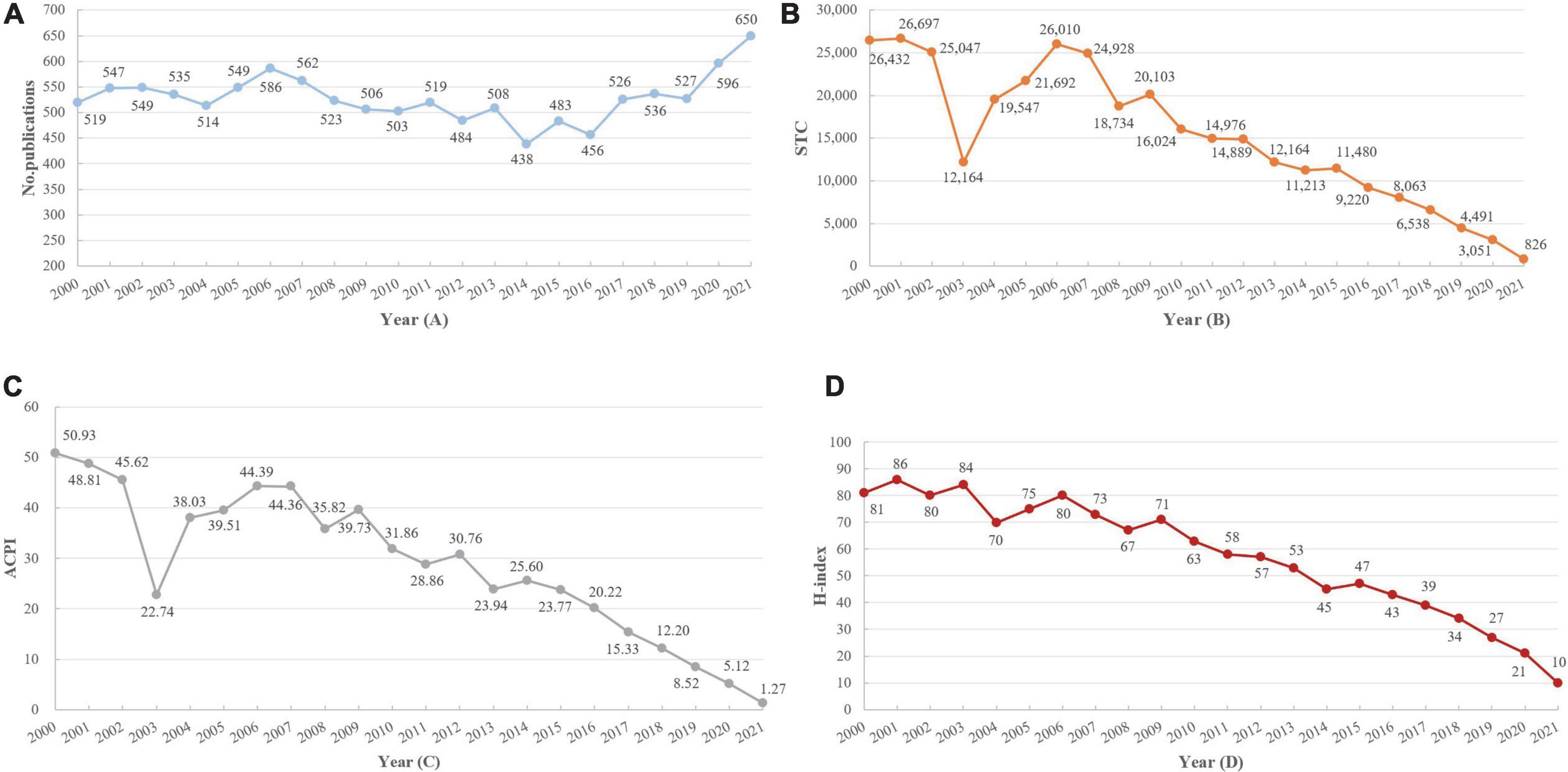
Figure 2. The annual number of menopausal hormone therapy (MHT)-related publications (A), STC (B), ACPI (C), and H-index (D).
The distribution of publications by journal
A total of 2,044 journals were included in MHT-related research during the study period. Table 1 shows the journals with more than 100 MHT-related publications. Over the past 22 years, Menopause-The Journal of The North American Menopause Society (1,070) showed the highest number of publications, followed by Maturitas (758) and Climacteric (499). In addition, 2020 IF ranged from 2.26 (Gynecological Endocrinology) to 7.329 (Fertility and Sterility). The 5-year IF ranged from 2.096 (Gynecological Endocrinology) to 7.366 (Human Reproduction). Moreover, the Journal of Clinical Endocrinology and Metabolism depicted the highest ACPI and H-index, indicating the higher quality of manuscripts published in this journal.

Table 1. Journals with more than 100 menopausal hormone therapy (MHT)-related publications (N = 11,616).
Distribution of publications by country
A total of 117 countries published MHT-related studies, of which 39.35% were from Europe, 33.11% from North America, and 19.11% from Asia (Figure 3). The density map included 76 countries, with a frequency ≥ 5 times (Figure 4). The figure showed that the top 10 countries were the United States of America (USA) with 4,373, followed by Italy (944), the United Kingdom (UK) (809), China (699), Canada (547), Australia (505), Japan (479), Germany (466), France (451, 4%), and Sweden (425) (Figure 4 and Table 2). Among the top-10 countries are 1/2 from Europe, 1/5 from North America, 1/5 from Asia, and 1/10 from Oceania (Table 2).
In terms of STC, h-index, and NCMCI among the top-10 countries, the USA contributed the most with the highest h-index (174), STC (184,255), and NCMCI (1,222), followed by the UK in h-index (92), STC (34,644), and NCMCI (914) (Table 2). As for ACPI, Australia showed the highest ACPI (44.8), followed by the UK (42.82), the USA (42.11), and France (41.64) (Table 2).
Among 11,616 MHT-related publications, 98 research areas were included. While addressing the top-5 research areas among top-10 countries, obstetrics-gynecology, endocrinology metabolism, and oncology areas were studied by all 10 countries. The USA published 1,433 MHT-related studies in the obstetrics-gynecology research area, then followed by Italy (405), the UK (233), Australia (200), and Sweden (172). Regarding endocrinology metabolism and oncology research areas, the USA had the largest publications, 543 and 548. Eight countries studied the geriatrics gerontology area except for USA and China. Among these eight countries, Italy had the most significant number of publications (121), then followed by the UK (62) and Sweden (60). The public environmental occupational health area was studied by the USA (389), UK (59), Germany (28), France (38), and Sweden (25) (Table 2).
Distribution of publications by institution
Table 3 shows the 13 institutions with more than 200 MHT-related publications. Among them, 9/13 were from the USA. League of European Research Universities (LERU) was the top-1 most publications (767), followed by the University of California System (616), Harvard University (561), Pennsylvania Commonwealth System of Higher Education (PCSHE) (343), Brigham and Women’s Hospital (303), and National Institutes of Health (NIH) (301). As for STC, the USA was at the top-1 with 36,565 citations, followed by Harvard University (35,553) and the University of California System (34,022). We observed that three institutions with an H-index higher than 90 were the University of California System (97), Harvard University (94), and LERU (93).
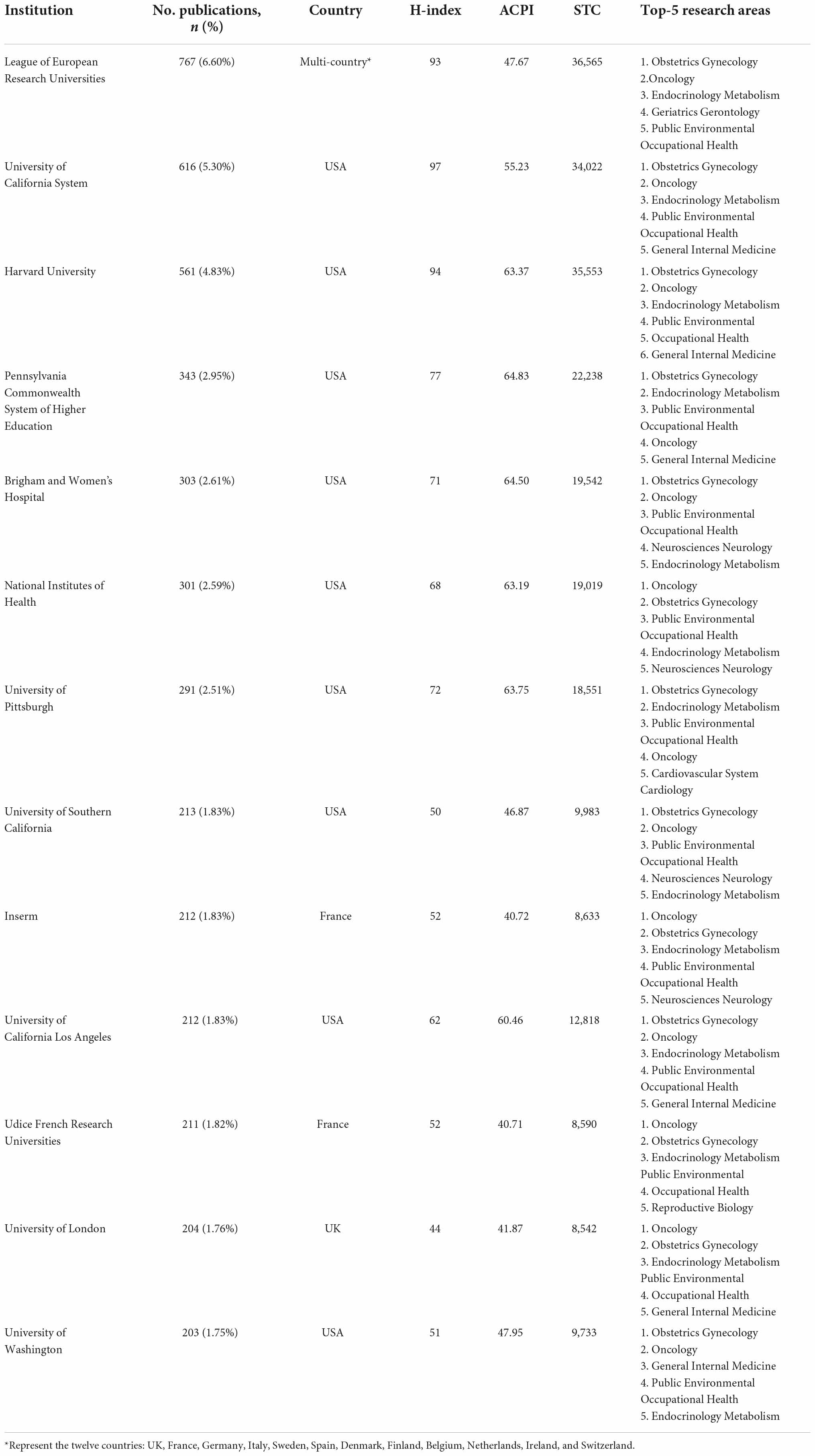
Table 3. Institutions having more than 200 menopausal hormone therapy (MHT)-related publications (N = 11,616).
We analyzed the top five research areas among the 13 institutions with more than 200 MHT-related publications. These 13 institutions mainly focused on obstetrics, gynecology, oncology, endocrinology metabolism, public environmental occupational health, and general internal medicine (Figure 5).
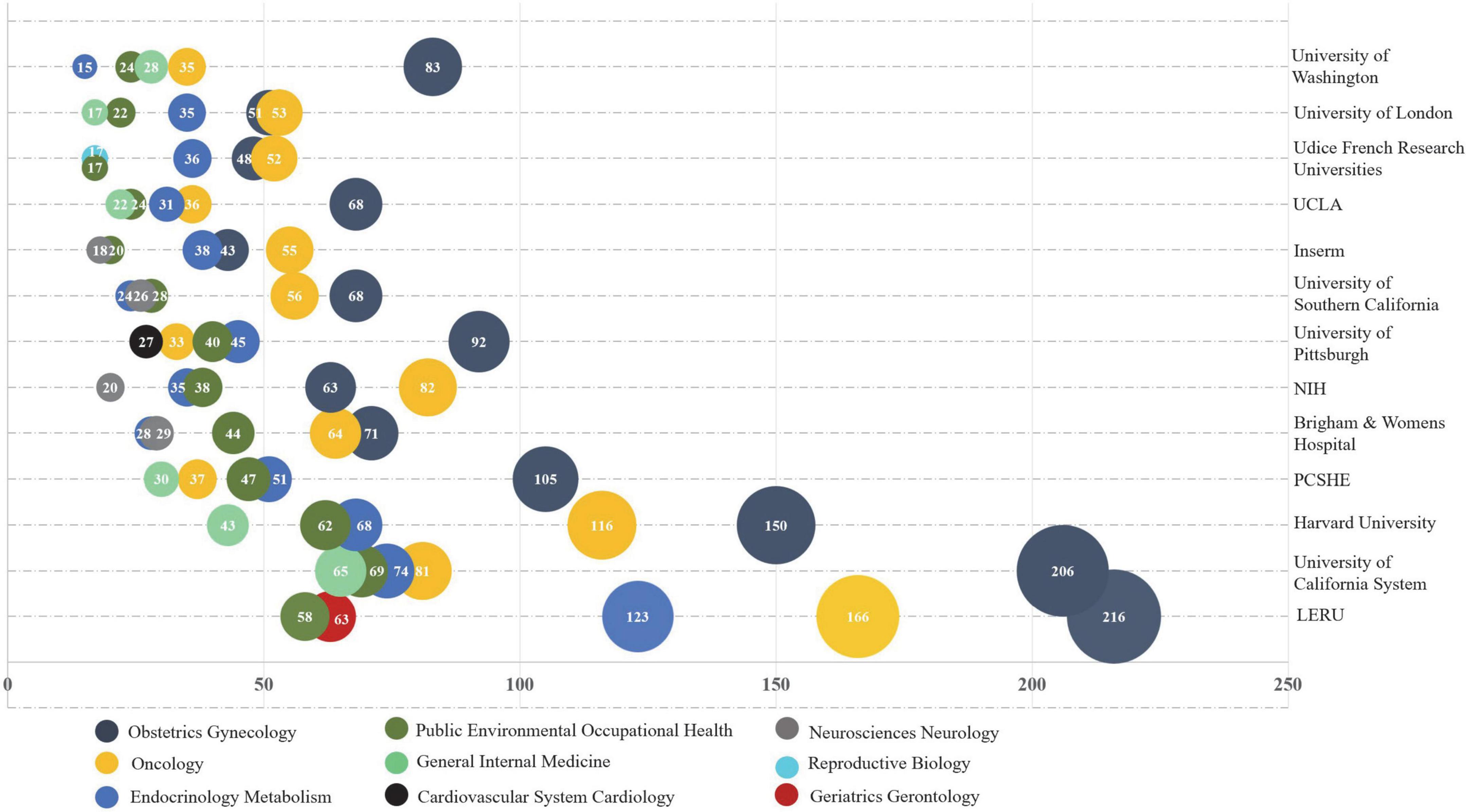
Figure 5. No. publications of top-5 research areas for the institutions with more than 200 menopausal hormone therapy (MHT)-related publications.
The distribution of publications by author
A total of 47,559 authors were included in MHT-related publications, 611 authors with a frequency ≥ 5 times were incorporated in the collaboration network analysis, and 31 clusters were created. Dr. JoAann Manson (USA), Dr. Susan Davis (Australia), Dr. Andrea Genazzani (Italy), and Dr. Nanette Santoro (USA) had the highest number of publications. They were distributed in different clusters, showing close cooperative relationships with other authors (Figure 6).
The top-10 authors with the most MHT-related publications mainly originated from the USA (3/5) and Italy (1/5) and were focused on Harvard University (1/5) and the University of Pisa (1/5) (Table 4). Most of the top-10 authors primarily focused on obstetrics gynecology, endocrinology metabolism, geriatrics gerontology, and seven research areas (Figure 7 and Table 4). The most-contributed research area of the top 10 authors was obstetrics gynecology (Figure 7).
Dr. JoAann Manson possessed the highest number of publications (90), STC (8,169), ACPI (90.77), and H-index (41), followed by Dr. Karen Matthews in STC (4,900), ACPI (85.96), and H-index (37), Dr. Hadine Joffe (32) and Dr. Nanette Santoro (31) in H-index, Dr. Susan Davis (4,190) and Dr. Nanette Santoro (3,036) in STC. In addition, Dr. JoAann Manson (1,175) had the highest NCMCI, followed by Dr. Susan Davis (621), Dr. Hadine Joffe (476), and Dr. Karen Matthews (349) (Table 4).
Analysis of hotspot
A total of 12,863 keywords were identified from the 11,616 publications, and 165 keywords with occurrence frequency ≥ 30 were clustered. In Figure 8, one type of color represented one cluster, and the following eight clusters were developed: cluster 1 (yellow area, 14 items), research on the symptoms of menopause; cluster 2 (green area, 32 items), reporting the various types of MHT; cluster 3 (purple area, 14 items), published some estrogen receptor medicine; cluster 4 (red area, 32 items), studies on the breast and endometrium diseases; cluster 5 (orange area, 15 items), reported on bone density-related indicators; cluster 6 (blue area, 26 items), the epidemiology of the risk factors; cluster 7 (light blue area, 17 items), studies regarding sexual function; and cluster 8 (brown area, nine items), research on the women’s health (Figure 8B).

Figure 8. (A) The keywords of number of occurrences more than 100. (B) The network map of keyword clustering showed 165 keywords with a minimal occurrence of 30 times and classified into eight clusters.
Next, we identified 42 keywords with a frequency ≥ 100. These keywords primarily focused on MHT, including estrogen (1,178) and estradiol (475), menopausal symptoms such as hot flashes (435), osteoporosis (561), and could be some adverse events of MHT such as cardiovascular disease (344), and cognitive impairment like the Alzheimer’s disease (100) (Figure 8A).
High-frequent citation articles
Most of the top-10 most-cited publications came from the USA and were published in high impact factor journals such as JAMA, BMJ, and NEJM. Dr. Jacques Rossouw published the most frequently cited article (1,175), followed by Dr. Edward Bixler (1,000), Dr. Gillian Reeves (914), and Dr. Ethel Siris (884) (Table 5).
Discussion
Compared with the annual number of cardiovascular disease-related publications ranging from 3,276 to 9,836 in the past 20 years (39), MHT-related publications ranged from 438 to 650 annually, demonstrated a very slow increase. The research hotpots primarily focused on MHT for treating menopausal symptoms and the impact of MHT on women’s health. The most contributions to MHT-related publications were from the USA based on country, LERU in terms of the institution, and Dr. JoAann Manson from Harvard University, regarding the authors. By comparing the research fields of different countries, institutions and authors, which had the highest number of publications, we found that obstetrics gynecology and endocrinology metabolism had the most extensive research, followed by oncology and geriatrics gerontology in terms of country, oncology, public environmental and occupational health in terms of institution, and geriatrics gerontology in terms of author.
In the 1960s, estrogen therapy was invested and approved for treating menopausal symptoms, with very high popularity in the 1990s (40, 41). The first clinical trial, Women’s Health Initiative (WHI), focused on MHT and chronic post-menopausal conditions, started in the USA in the late 1990s (42). Prevalence of vasomotor symptoms alone is estimated at 40–50 million women in the USA, accounting for 38% among 1.2 billion women worldwide that will be menopausal or post-menopausal by 2030 (43). Based on the WHI that investigated about MHT and menopausal women, the USA became the country with the largest number of publications. After the announcement of the first results of WHI in 2002, MHT had more harms than benefits for health, then MHT usage was dropped (44). Simultaneously, our study showed a rapid decrease in MHT-related STC from 2002 (25,047) to 2003 (12,164) and ACPI from 2002 (45.62) to 2003 (22.74).
After that, MHT-related adverse events became the research hotspot. As shown in our study, the high-frequency keywords included breast cancer (924), cardiovascular disease (344), and cognition (185). However, the results from the clinical trials and observational studies regarding MHT adverse events remain inconsistent. On the one hand, the largest randomized controlled trial of MHT, WHI, which allocated post-menopausal women either to the placebo or the conjugated equine estrogen with medroxyprogesterone group, the latter depicted an increased 1.76 times risk of dementia (13) and 1.28 times risk of breast cancer (14). Additionally, the result showed 1.35 times more risk of stroke (15). On the other hand, some observational studies reported a reduced risk of Alzheimer’s disease and all-cause dementia in users of MHT (11, 16–18), and the use of exogenous estrogens were cardio-protective for post-menopausal women (10). Moreover, some randomized trials, such as the Danish Osteoporosis Prevention Study, observed that those receiving MHT showed a significantly reduced risk of the primary CVD composite endpoint compared to no treatment (HR: 0.48, 95% CI 0.26–0.87). The randomized trials named Kronos Early Estrogen Prevention Study and the Early Versus Late Intervention Trial with Estradiol have demonstrated a favorable safety profile of MHT when started early during menopause (45–47). Recent reviews attributed these inconsistencies to woman’s age, the duration of time since menopause, and different types and routes of administration (7, 12, 48). Therefore, results from the clinical trials and observational studies regarding MHT adverse events remain inconsistent. Thus, evidence of mechanisms can be decisive, enabling researchers to explain, predict, and intervene (19). Additionally, our study showed that the evidence regarding mechanisms was limited, so mechanistic research could be a potential research hotspot.
Strength and limitations
Since this was the first bibliometrics analysis of MHT-related publications, our study provided a good insight into research hotpots, exposed the evidence gap, and provided research ideas for researchers. In this bibliometric analysis, we also explored the top-5 research areas of the top-10 countries and top-10 authors.
However, our study had certain limitations. Firstly, although most MHT-related research manuscripts were indexed in the WOS database, our study could have omitted some important studies (49–51). Secondly, only English documents were included in our analysis based on the inclusion criteria. Thus, some essential non-English studies might have been excluded from the assessment. Thirdly, we selected the study types through the filters in the WOSCC. A small number of meta-analyses may index as articles. Some of the data we analyzed were automatically extracted from the downloaded publications by the software, like the authors’ names. The software could not distinguish between authors with the same name, which might affect the results of our study.
Conclusion
Menopausal hormone therapy (MHT)-related publications revealed a very slow increase trend. The USA played a vital role in MHT-related studies. Moreover, Dr. JoAann Manson from the University of Harvard had the most contributions. The research topics primarily focused on treating menopausal symptoms and the impact of MHT on women’s health. Results from the clinical trials and observational studies regarding MHT adverse events remain inconsistent. To clarify this inconsistency, more researchers should focus on adverse events and their mechanisms.
Data availability statement
The datasets presented in this study can be found in online repositories. The names of the repository/repositories and accession number(s) can be found in the article/Supplementary material.
Ethics statement
Ethical review and approval was not required for the study on human participants in accordance with the local legislation and institutional requirements. Written informed consent for participation was not required for this study in accordance with the national legislation and the institutional requirements.
Author contributions
KY, JL, ZW, and CQ led the team, were responsible for all aspects of the project, and contributed to the conception and design of the work. JL and ZW were in charge of the literature search and data acquisition. JL, ZW, JW, KM, XL, YY, YL, NZ, AS, JH, and CQ collected, analyzed, and interpreted the data. JL, ZW, JW, KM, XL, and YY wrote the first draft of the manuscript. JL, KY, and CQ were responsible for the editing and standardization of the tables and figures and gave critical advice on the manuscript. All authors contributed to the manuscript revision, read, and approved the submitted version.
Funding
This review was supported by funding of the Major Project of the National Social Science Fund of China: Research on the Theoretical System, International Experience, and Chinese Path of Evidence-Based Social Science (No.: 19ZDA142).
Conflict of interest
The authors declare that the research was conducted in the absence of any commercial or financial relationships that could be construed as a potential conflict of interest.
Publisher’s note
All claims expressed in this article are solely those of the authors and do not necessarily represent those of their affiliated organizations, or those of the publisher, the editors and the reviewers. Any product that may be evaluated in this article, or claim that may be made by its manufacturer, is not guaranteed or endorsed by the publisher.
Supplementary material
The Supplementary Material for this article can be found online at: https://www.frontiersin.org/articles/10.3389/fmed.2022.952487/full#supplementary-material
References
1. Avis NE, Crawford SL, Greendale G, Bromberger JT, Everson-Rose SA, Gold EB, et al. Duration of menopausal vasomotor symptoms over the menopause transition. JAMA Int Med. (2015) 175:531–9. doi: 10.1001/jamainternmed.2014.8063
2. Center for Women’s Mental Health.The immense burden of menopausal symptoms. (2015). Available online at: https://womensmentalhealth.org/posts/the-immense-burden-of-menopausal-symptoms/#:~:text=Several%20recent%20articles%20suggest%20that,transition%20into%20the%20menopause%20phase (accessed April 28, 2022).
3. Stuenkel CA. Managing menopausal vasomotor symptoms in older women. Maturitas. (2021) 143:36–40. doi: 10.1016/j.maturitas.2020.08.005
4. Nappi RE, Kroll R, Siddiqui E, Stoykova B, Rea C, Gemmen E, et al. Global cross-sectional survey of women with vasomotor symptoms associated with menopause: prevalence and quality of life burden. Menopause. (2021) 28:875–82. doi: 10.1097/GME.0000000000001793
5. Maclennan AH, Broadbent JL, Lester S, Moore V. Oral oestrogen and combined oestrogen/progestogen therapy versus placebo for hot flushes. Cochrane Database Syst Rev. (2004) 2004:Cd002978. doi: 10.1002/14651858.CD002978.pub2
6. Shifren JL, Crandall CJ, Manson JE. Menopausal hormone therapy. JAMA. (2019) 321:2458–9. doi: 10.1001/jama.2019.5346
7. Mehta J, Kling JM, Manson JE. Risks, benefits, and treatment modalities of menopausal hormone therapy: current concepts. Front Endocrinol. (2021) 12:564781. doi: 10.3389/fendo.2021.564781
8. Sandset PM, Høibraaten E, Eilertsen AL, Dahm A. Mechanisms of thrombosis related to hormone therapy. Throm Res. (2009) 123:S70–3. doi: 10.1016/S0049-3848(09)70015-5
9. Mauvais-Jarvis F, Manson JE, Stevenson JC, Fonseca VA. Menopausal hormone therapy and type 2 diabetes prevention: evidence, mechanisms, and clinical implications. Endocrine Rev. (2017) 38:173–88. doi: 10.1210/er.2016-1146
10. Grodstein F, Stampfer MJ, Manson JE, Colditz GA, Willett WC, Rosner B, et al. Postmenopausal estrogen and progestin use and the risk of cardiovascular disease. New England J Med. (1996) 335:453–61. doi: 10.1056/NEJM199608153350701
11. O’Brien J, Jackson JW, Grodstein F, Blacker D, Weuve J. Postmenopausal hormone therapy is not associated with risk of all-cause dementia and Alzheimer’s disease. Epidemiol Rev. (2014) 36:83–103. doi: 10.1093/epirev/mxt008
12. Lundberg G, Wu P, Wenger N. Menopausal hormone therapy: a comprehensive review. Curr Atheros Rep. (2020) 22:33. doi: 10.1007/s11883-020-00854-8
13. Shumaker SA, Legault C, Kuller L, Rapp SR, Thal L, Lane DS, et al. Conjugated equine estrogens and incidence of probable dementia and mild cognitive impairment in postmenopausal women: women’s health initiative memory study. JAMA. (2004) 291:2947–58. doi: 10.1001/jama.291.24.2947
14. Chlebowski RT, Anderson GL, Aragaki AK, Manson JE, Stefanick ML, Pan K, et al. Association of menopausal hormone therapy with breast cancer incidence and mortality during long-term follow-up of the women’s health initiative randomized clinical trials. JAMA. (2020) 324:369–80. doi: 10.1001/jama.2020.9482
15. Manson JE, Chlebowski RT, Stefanick ML, Aragaki AK, Rossouw JE, Prentice RL, et al. Menopausal hormone therapy and health outcomes during the intervention and extended poststopping phases of the women’s health initiative randomized trials. JAMA. (2013) 310:1353–68. doi: 10.1001/jama.2013.278040
16. Tang MX, Jacobs D, Stern Y, Marder K, Schofield P, Gurland B, et al. Effect of oestrogen during menopause on risk and age at onset of Alzheimer’s disease. Lancet. (1996) 348:429–32. doi: 10.1016/S0140-6736(96)03356-9
17. Zandi PP, Carlson MC, Plassman BL, Welsh-Bohmer KA, Mayer LS, Steffens DC, et al. Hormone replacement therapy and incidence of alzheimer disease in older women: the cache county study. JAMA. (2002) 288:2123–9. doi: 10.1001/jama.288.17.2123
18. Imtiaz B, Taipale H, Tanskanen A, Tiihonen M, Kivipelto M, Heikkinen AM, et al. Risk of Alzheimer’s disease among users of postmenopausal hormone therapy: a nationwide case-control study. Maturitas. (2017) 98:7–13. doi: 10.1016/j.maturitas.2017.01.002
19. Parkkinen, VP, Wallmann C, Wilde M. Evaluating evidence of mechanisms in medicine: principles and procedures. (2018). Available online at: https://www.ncbi.nlm.nih.gov/books/NBK543865/ (accessed April 20, 2022).
20. Donthu N, Kumar S, Mukherjee D, Pandey N, Lim WM. How to conduct a bibliometric analysis: an overview and guidelines. J Bus Res. (2021) 133:285–96. doi: 10.1016/j.jbusres.2021.04.070
21. Yan P, Li M, Li J, Lu Z, Hui X, Bai Y, et al. Bibliometric analysis and systematic review of global coronavirus research trends before covid-19: prospects and implications for covid-19 research. Front Med. (2021) 8:729138. doi: 10.3389/fmed.2021.729138
22. Guler AT, Waaijer CJ, Palmblad M. Scientific workflows for bibliometrics. Scientometrics. (2016) 107:385–98. doi: 10.1007/s11192-016-1885-6
23. Wang C, Guan D, Li Z, Yang Y, Yang K. Emerging trends and frontier research on recurrent implantation failure: a bibliometric analysis. Ann Trans Med. (2022) 10:307. doi: 10.21037/atm-22-703
24. Xu Z, Liu R, Guo L, Gao Z, Gao Z, Liu X, et al. The 100 most-cited articles on bibliotherapy: a bibliometric analysis. Psychol Health Med. (2022) 2022:1–17. doi: 10.1080/13548506.2022.2068183
25. Reuters T. (2021). Available online at: https://jcr.clarivate.com/jcr/search-results (accessed May 10, 2022).
26. van Eck NJ, Waltman L. Software survey: vosviewer, a computer program for bibliometric mapping. Scientometrics. (2010) 84:523–38. doi: 10.1007/s11192-009-0146-3
27. Ziegler B. Methods for Bibliometric Analysis of Research: Renewable Energy Case Study. Cambridge, MA: Massachusetts Institute of Technology (2009).
28. Li X, Li Y, Guo K, Chen N, Cui X, Bai Z, et al. Evidence based social science in china paper 3: the quality of social science rcts published from 2000-2020. J Clin Epidemiol. (2022) 141:64–73. doi: 10.1016/j.jclinepi.2021.09.014
29. Rossouw JE, Prentice RL, Manson JE, Wu L, Barad D, Barnabei VM, et al. Postmenopausal hormone therapy and risk of cardiovascular disease by age and years since menopause. JAMA. (2007) 297:1465–77. doi: 10.1001/jama.297.13.1465
30. Bixler EO, Vgontzas AN, Lin HM, Have TT, Rein J, Vela-Bueno A, et al. Prevalence of sleep-disordered breathing in women: effects of gender. Am J Respir Crit Care Med. (2001) 163:608–13. doi: 10.1164/ajrccm.163.3.9911064
31. Reeves GK, Pirie K, Beral V, Green J, Spencer E, Bull D. Cancer incidence and mortality in relation to body mass index in the million women study: cohort study. BMJ. (2007) 335:1134. doi: 10.1136/bmj.39367.495995.AE
32. Siris ES, Miller PD, Barrett-Connor E, Faulkner KG, Wehren LE, Abbott TA, et al. Identification and fracture outcomes of undiagnosed low bone mineral density in postmenopausal women: results from the national osteoporosis risk assessment. JAMA. (2001) 286:2815–22. doi: 10.1001/jama.286.22.2815
33. Turner NC, Ro J, André F, Verma S, Iwata H, Harbeck N, et al. Palbociclib in hormone-receptor-positive advanced breast cancer. New England J Med. (2015) 373:209–19. doi: 10.1056/NEJMoa1505270
34. Schairer C, Lubin J, Troisi R, Sturgeon S, Brinton L, Hoover R. Menopausal estrogen and estrogen-progestin replacement therapy and breast cancer risk. JAMA. (2000) 283:485–91. doi: 10.1001/jama.283.4.485
35. Binder EB, Künzel HE, Nickel T, Kern N, Pfennig A, Majer M, et al. Hpa-axis regulation at in-patient admission is associated with antidepressant therapy outcome in male but not in female depressed patients. Psychoneuroendocrinology. (2009) 34:99–109. doi: 10.1016/j.psyneuen.2008.08.018
36. Davison SL, Bell R, Donath S, Montalto JG, Davis SR. Androgen levels in adult females: changes with age. Menopause, and oophorectomy. J Clin Endocrinol Metab. (2005) 90:3847–53. doi: 10.1210/jc.2005-0212
37. Shifren JL, Braunstein GD, Simon JA, Casson PR, Buster JE, Redmond GP, et al. Transdermal testosterone treatment in women with impaired sexual function after oophorectomy. New England J Med. (2000) 343:682–8. doi: 10.1056/NEJM200009073431002
38. Dennerstein L, Dudley EC, Hopper JL, Guthrie JR, Burger HGA. Prospective population-based study of menopausal symptoms. Obstetrics Gynecol. (2000) 96:351–8. doi: 10.1016/S0029-784400930-3
39. Gal D, Thijs B, Glänzel W, Sipido KR. Hot topics and trends in cardiovascular research. Eur Heart J. (2019) 40:2363–74.
40. Cagnacci A, Venier M. The controversial history of hormone replacement therapy. Medicina. (2019) 55:602. doi: 10.3390/medicina55090602
41. Puljak L. Evidence synthesis and methodological research on evidence in medicine-why it really is research and it really is medicine. J Evid Based Med. (2020) 13:253–4. doi: 10.1111/jebm.12417
42. Women’s Health Initiative.Women’s Health Initiative. (2021). Available online at: https://www.whi.org/ (accessed 2022 May 13)
43. Who. Research on the menopause in the 1990s. Report of a who scientific group. World Health Organization Technical Report Series. (1996) 866:1–107.
44. Rossouw JE, Anderson GL, Prentice RL, LaCroix AZ, Kooperberg C, Stefanick ML, et al. Risks and benefits of estrogen plus progestin in healthy postmenopausal women: principal results from the women’s health initiative randomized controlled trial. JAMA. (2002) 288:321–33. doi: 10.1001/jama.288.3.321
45. Miller VM, Black DM, Brinton EA, Budoff MJ, Cedars MI, Hodis HN, et al. Using basic science to design a clinical trial: baseline characteristics of women enrolled in the kronos early estrogen prevention study (keeps). J Cardiovas Trans Res. (2009) 2:228–39. doi: 10.1007/s12265-009-9104-y
46. Hodis HN, Mack WJ. The timing hypothesis and hormone replacement therapy: a paradigm shift in the primary prevention of coronary heart disease in women. Part 1: comparison of therapeutic efficacy. J Am Geriatr Soc. (2013) 61:1005–10. doi: 10.1111/jgs.12140
47. Schierbeck LL, Rejnmark L, Tofteng CL, Stilgren L, Eiken P, Mosekilde L, et al. Effect of hormone replacement therapy on cardiovascular events in recently postmenopausal women: randomised trial. BMJ. (2012) 345:e6409. doi: 10.1136/bmj.e6409
48. Zhang GQ, Chen JL, Luo Y, Mathur MB, Anagnostis P, Nurmatov U, et al. Menopausal hormone therapy and Women’s health: an umbrella review. PLoS Med. (2021) 18:e1003731. doi: 10.1371/journal.pmed.1003731
49. Ge L, Tian JH, Li YN, Pan JX, Li G, Wei D, et al. Association between prospective registration and overall reporting and methodological quality of systematic reviews: a meta-epidemiological study. J Clin Epidemiol. (2018) 93: 45–55.
50. Li Y, Cao L, Zhang Z, Hou L, Qin Y, Hui X, et al. Reporting and methodological quality of covid-19 systematic reviews needs to be improved: an evidence mapping. J Clin Epidemiol. (2021) 135:17–28. doi: 10.1016/j.jclinepi.2021.02.021
Keywords: menopausal hormone therapy, menopausal women, treatment, adverse events, bibliometric analysis
Citation: Li J, Wei Z, Wu J, Min K, Li X, Yao Y, Li Y, Zhang N, Shi A, Han J, Qiao C and Yang K (2022) Trends in research related to menopausal hormone therapy from 2000 to 2021: A bibliometric analysis. Front. Med. 9:952487. doi: 10.3389/fmed.2022.952487
Received: 25 May 2022; Accepted: 11 October 2022;
Published: 28 October 2022.
Edited by:
Andrea Tinelli, Xi’an Jiaotong University, ChinaReviewed by:
Juliana Michele Kling, Mayo Clinic Arizona, United StatesMihnea-Alexandru Gǎman, Carol Davila University of Medicine and Pharmacy, Romania
Copyright © 2022 Li, Wei, Wu, Min, Li, Yao, Li, Zhang, Shi, Han, Qiao and Yang. This is an open-access article distributed under the terms of the Creative Commons Attribution License (CC BY). The use, distribution or reproduction in other forums is permitted, provided the original author(s) and the copyright owner(s) are credited and that the original publication in this journal is cited, in accordance with accepted academic practice. No use, distribution or reproduction is permitted which does not comply with these terms.
*Correspondence: Kehu Yang, eWFuZ2toLWVibUBsenUuZWR1LmNu; Chengdong Qiao, cWlhb2NoZW5nZG9uZzIwMjJAMTI2LmNvbQ==
†These authors have contributed equally to this work and share first authorship
 Jing Li
Jing Li Zhipeng Wei
Zhipeng Wei Jingxi Wu
Jingxi Wu Kaili Min
Kaili Min Xiao Li
Xiao Li Yuan Yao
Yuan Yao Yao Li
Yao Li Ningning Zhang
Ningning Zhang Anya Shi
Anya Shi Jiani Han
Jiani Han Chengdong Qiao
Chengdong Qiao Kehu Yang
Kehu Yang